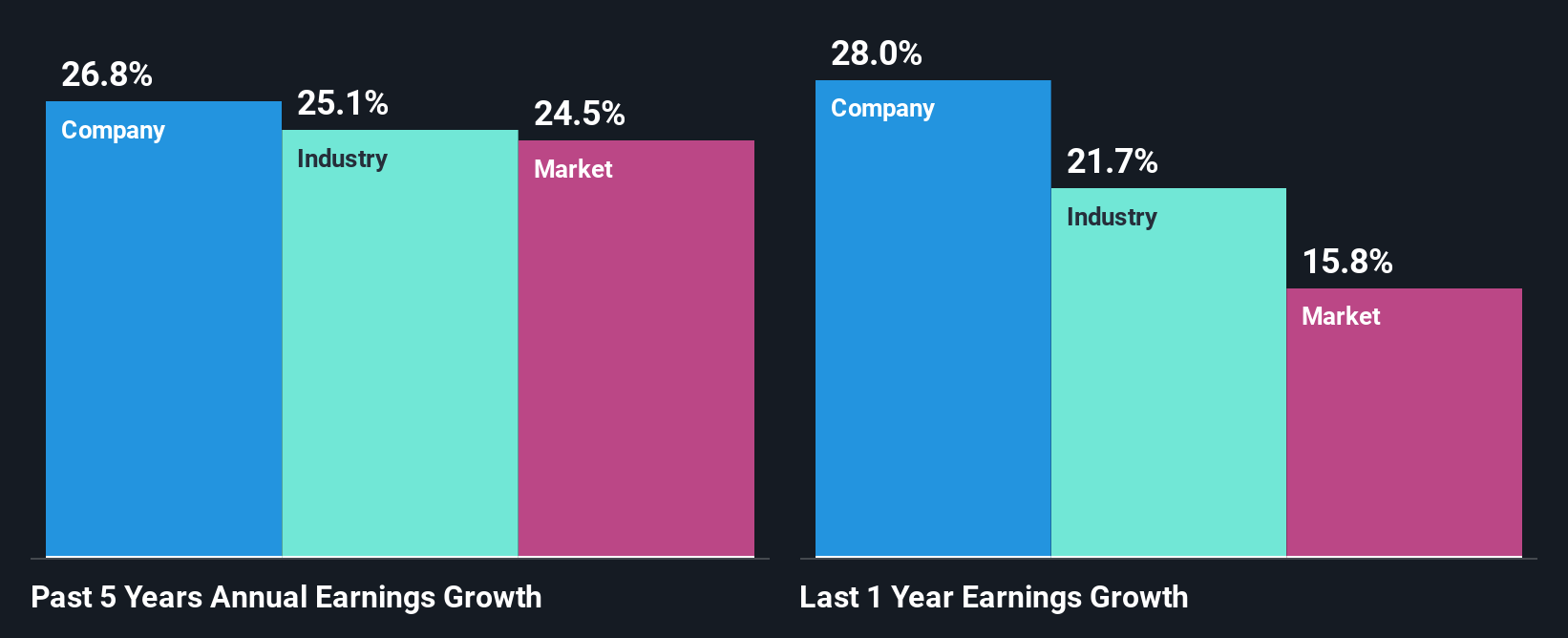Is Persistent Systems Limited's (NSE:PERSISTENT) Latest Stock Performance Being Led By Its Strong Fundamentals?
Most readers would already know that Persistent Systems' (NSE:PERSISTENT) stock increased by 7.1% over the past three months. Since the market usually pay for a company’s long-term financial health, we decided to study the company’s fundamentals to see if they could be influencing the market. Particularly, we will be paying attention to Persistent Systems' ROE today.
Return on equity or ROE is a key measure used to assess how efficiently a company's management is utilizing the company's capital. In short, ROE shows the profit each dollar generates with respect to its shareholder investments.
How To Calculate Return On Equity?
The formula for return on equity is:
Return on Equity = Net Profit (from continuing operations) ÷ Shareholders' Equity
So, based on the above formula, the ROE for Persistent Systems is:
22% = ₹14b ÷ ₹63b (Based on the trailing twelve months to March 2025).
The 'return' is the income the business earned over the last year. So, this means that for every ₹1 of its shareholder's investments, the company generates a profit of ₹0.22.
See our latest analysis for Persistent Systems
What Has ROE Got To Do With Earnings Growth?
So far, we've learned that ROE is a measure of a company's profitability. We now need to evaluate how much profit the company reinvests or "retains" for future growth which then gives us an idea about the growth potential of the company. Assuming all else is equal, companies that have both a higher return on equity and higher profit retention are usually the ones that have a higher growth rate when compared to companies that don't have the same features.
Persistent Systems' Earnings Growth And 22% ROE
To begin with, Persistent Systems seems to have a respectable ROE. Especially when compared to the industry average of 15% the company's ROE looks pretty impressive. This certainly adds some context to Persistent Systems' exceptional 27% net income growth seen over the past five years. We reckon that there could also be other factors at play here. Such as - high earnings retention or an efficient management in place.
We then performed a comparison between Persistent Systems' net income growth with the industry, which revealed that the company's growth is similar to the average industry growth of 25% in the same 5-year period.

Earnings growth is a huge factor in stock valuation. What investors need to determine next is if the expected earnings growth, or the lack of it, is already built into the share price. By doing so, they will have an idea if the stock is headed into clear blue waters or if swampy waters await. Is Persistent Systems fairly valued compared to other companies? These 3 valuation measures might help you decide.
Is Persistent Systems Making Efficient Use Of Its Profits?
Persistent Systems' three-year median payout ratio is a pretty moderate 34%, meaning the company retains 66% of its income. By the looks of it, the dividend is well covered and Persistent Systems is reinvesting its profits efficiently as evidenced by its exceptional growth which we discussed above.
Besides, Persistent Systems has been paying dividends for at least ten years or more. This shows that the company is committed to sharing profits with its shareholders. Upon studying the latest analysts' consensus data, we found that the company is expected to keep paying out approximately 39% of its profits over the next three years. As a result, Persistent Systems' ROE is not expected to change by much either, which we inferred from the analyst estimate of 27% for future ROE.

Summary
Overall, we are quite pleased with Persistent Systems' performance. Particularly, we like that the company is reinvesting heavily into its business, and at a high rate of return. Unsurprisingly, this has led to an impressive earnings growth. That being so, a study of the latest analyst forecasts show that the company is expected to see a slowdown in its future earnings growth. Are these analysts expectations based on the broad expectations for the industry, or on the company's fundamentals? Click here to be taken to our analyst's forecasts page for the company.
Have feedback on this article? Concerned about the content? Get in touch with us directly. Alternatively, email editorial-team (at) simplywallst.com.
This article by Simply Wall St is general in nature. We provide commentary based on historical data and analyst forecasts only using an unbiased methodology and our articles are not intended to be financial advice. It does not constitute a recommendation to buy or sell any stock, and does not take account of your objectives, or your financial situation. We aim to bring you long-term focused analysis driven by fundamental data. Note that our analysis may not factor in the latest price-sensitive company announcements or qualitative material. Simply Wall St has no position in any stocks mentioned.
 Wall Street Journal
Wall Street Journal